Amazon Kindle Fire Review
by Anand Lal Shimpi & Vivek Gowri on November 29, 2011 3:31 AM EST- Posted in
- Tablets
- Mobile
- Amazon
- Kindle Fire
- Kindle
The iPad Comparison
I'll be honest here (I always am?): I don't understand the iPad comparison. The Kindle Fire and iPad 2 couldn't be more different. They are vastly different sizes, shapes and prices. They even serve slightly different functions. The search for an iPad killer reminds me of the search for a Voodoo killer back during the heyday of 3dfx in the late 1990s.
The Kindle Fire serves entirely different purposes than to take marketshare away from Apple.
Why would Amazon enter the IPS LCD equipped multitouch tablet business to begin with? For users who are content reading ebooks on an e-ink screen, the vanilla Kindles are as good as they get. The problem is for users looking to consolidate devices, they may find themselves carrying a Kindle and a tablet of some sort (likely an iPad) and will ultimately ditch the Kindle in favor of the iPad. Should these users replace their Kindles with iPads, there's the argument that Apple could tempt them away from Amazon's Kindle store altogether. If they want a more affordable tablet however they are likely going to be forced into a solution that's probably not very good. Neither possibility is something Amazon likes, so the obvious answer is to offer a Kindle that delivers enough of the tablet experience that will satisfy those users looking for more than an e-ink Kindle could provide.
The Fire is that Kindle.
No Tradeoffs: Compute & Display
When faced with the task of bringing a not-sucky $200 tablet to market, Amazon refused to skimp in two areas: compute and the display. It reaffirms something that we've known for quite a while: to deliver the best user experience you still need fast silicon and a great display. The third thing you need is efficient software, which is something Amazon attempted to deliver by customizing Android, but I'll get to that later.
The SoC doesn't sound fast anymore, not with Tegra 3 and Krait waiting around the corner, but the OMAP 4430 is still one of the fastest things you can buy today. It features two fully equipped Cortex A9 cores (complete with MPE), a 1MB shared L2 cache, two 32-bit LPDDR2 memory channels and a PowerVR SGX 540. CPU clocks aren't as high as they could be at 1GHz, but if Amazon does its job well enough on the software side they should be sufficient. To put things into perspective, this is more general purpose compute than the original iPad and something competitive with the iPad 2. It only falls short of the iPad 2 in the GPU department, but seeing as the Kindle Fire isn't designed to be a big gaming platform the loss isn't significant.
| Tablet Specification Comparison | ||||||
| Amazon Kindle Fire | Apple iPad 2 | BlackBerry PlayBook | Samsung Galaxy Tab 8.9 | |||
| Dimensions | 190 x 120 x 11.4mm | 241.2 x 185.7 x 8.8mm | 194 x 130 x 10mm | 230.9 x 157.8 x 8.6mm | ||
| Display | 7-inch 1024 x 600 IPS | 9.7-inch 1024 x 768 IPS | 7-inch 1024 x 600 | 8.9-inch 1280 x 800 PLS | ||
| Weight | 413g | 601g | 425g | 447g | ||
| Processor | 1GHz TI OMAP 4430 (2 x Cortex A9) | 1GHz Apple A5 (2 x Cortex A9) | 1GHz TI OMAP 4430 (2 x Cortex A9) | 1GHz NVIDIA Tegra 2 (2 x Cortex A9) | ||
| Memory | 512MB | 512MB | 1GB | 1GB | ||
| Storage | 8GB | 16GB | 16GB | 16GB | ||
| Pricing | $199 | $499 | $199 | $469 | ||
The Fire is equipped with only 512MB of RAM but, once again, if Amazon does its job on the software side this should be sufficient. Moving to 1GB would allow you to keep more applications active at once and pave the way for more textures in games, but as I just mentioned, the Fire isn't much of a gaming platform to begin with.
The display is small by iPad standards, but as I mentioned in our PlayBook review, it does make the device far more likely to be by your side wherever you may go. The iPad and other 10-inch tablets make for a far better web browsing experience, but they are too big to just carry around with you like you would a wallet or smartphone. The Kindle Fire is bigger than anything that should occupy space in your wallet, but it's small enough that you might actually take it wherever you go.
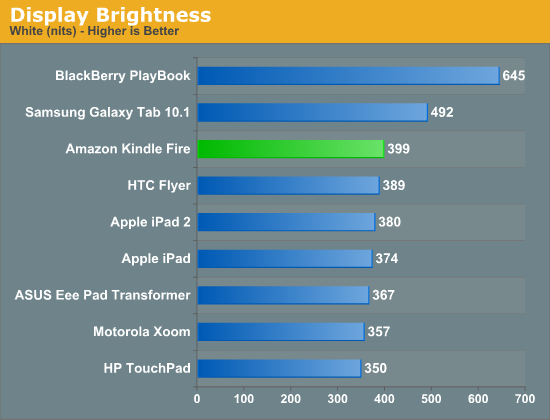
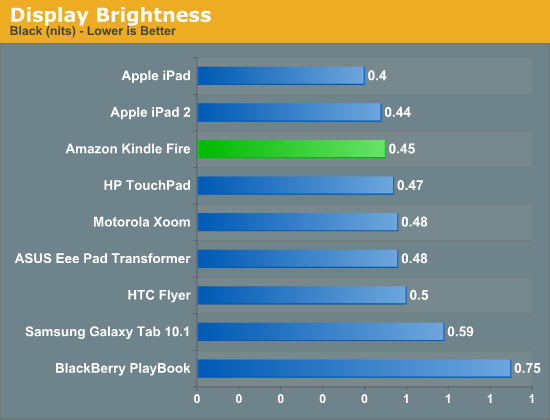
Display quality is pretty good. The 7-inch 1024 x 600 screen hits 400 nits at its brightest setting, and its black levels are reasonable at 0.45 nits. The resulting contrast ratio is good as well.
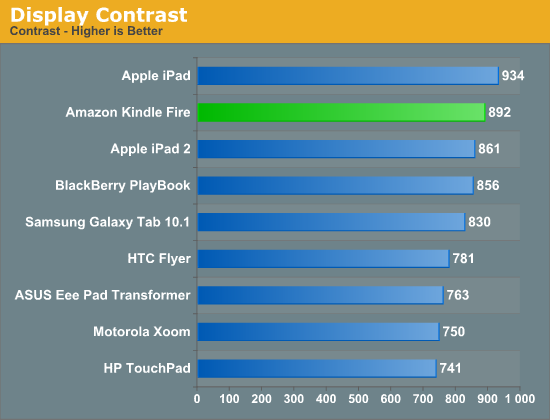
The white point is an almost Samsung-like 7200K across all brightness settings. Interestingly enough there's no difference in brightness once you get below 25% on the slider control.
The Form Factor
The first Kindle I ever bought was the second generation model. Upon receiving it I felt that it was the perfect handheld tablet form factor. The 2nd generation Kindle was both thin and light enough that it could truly be a book replacement. I'd carry it everywhere and it wasn't a burden to hold and read for hours.
The Kindle Fire strikes me with no similar feelings about its form factor. It's portable, more so than the iPad and it's reminds me of my old Kindle in surface area but that's it. The Fire is light enough to be held in one hand but when reading for extended periods of time I still find myself having to support the device with my chest if I'm lying on my back. There's simply no innovation in the form factor. While my old Kindle was the perfect form factor, the Fire is just acceptable.
This isn't all Amazon's fault however. The hardware in a plain old Kindle allows Amazon to build something ultra thin and ultra light. Moore's Law has yet to give us something that can perform as well as the Fire while operating within the confines (battery included) of a regular Kindle. I suspect that we'll eventually get to that point, however it may take a good three years for that to happen.
The standard Kindle's e-ink display is beautiful to read pages of books on, but it is hardly desirable for images or web content. The Kindle Fire is a bit better, but still not perfect in this regard. In text mode reading magazines or books is as pleasant as can be given that you're staring at an LED backlit LCD. If you're just going to be reading books, the experience on a vanilla Kindle is better. The advantage to the Fire of course is that you can do more than just read pages of text - it's good for magazines and web pages as well.
Unfortunately here the 7-inch 1024 x 600 display is limiting. It's virtually impossible to read a magazine (in magazine view) fully zoomed out like you would a book. I found myself preferring the text view of magazines I tried subscribing to on the Kindle Fire. Web browsing is more of a mixed bag. You get a really great browsing experience compared to a smartphone, or a really cramped browsing experience compared to an iPad. This is the same problem I pointed out in our PlayBook review:
Even when I'm not out and about, the PlayBook is quite usable as a content consumption device. In portrait mode fonts are a bit too small for me to read comfortably on the couch but in landscape it works well as a reddit browsing machine.It's in the couch-lounging usage model that the PlayBook does fall short of the iPad or Xoom. But in terms of portability the PlayBook is clearly a much better balance of functionality and mobility. If you read between the lines you'll come to the same conclusion I have: neither the PlayBook nor the iPad is the perfect form factor for a tablet. Further more, I'm not sure there is a single perfect tablet form factor.


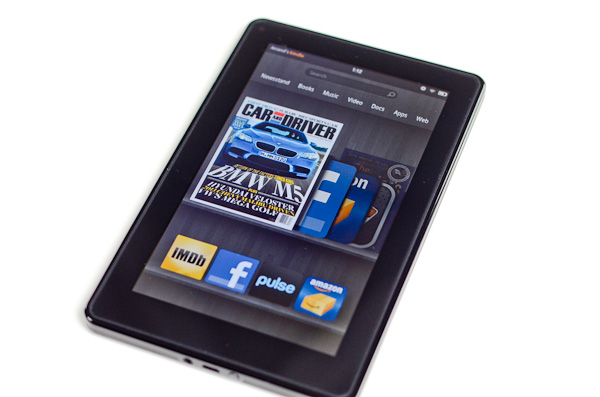
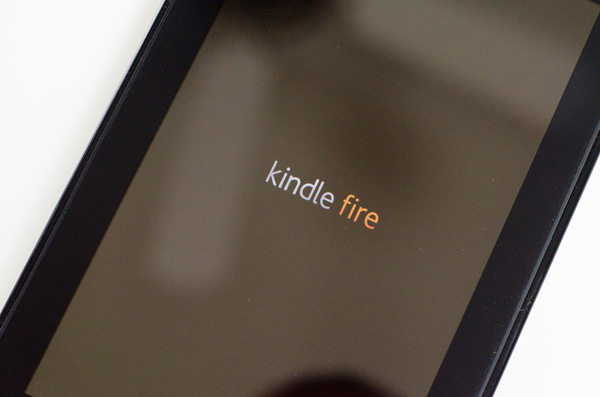
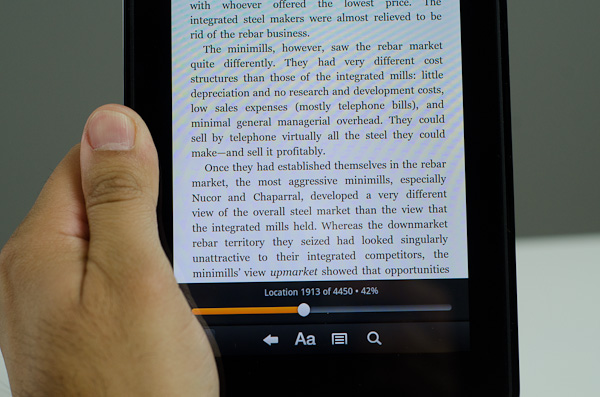
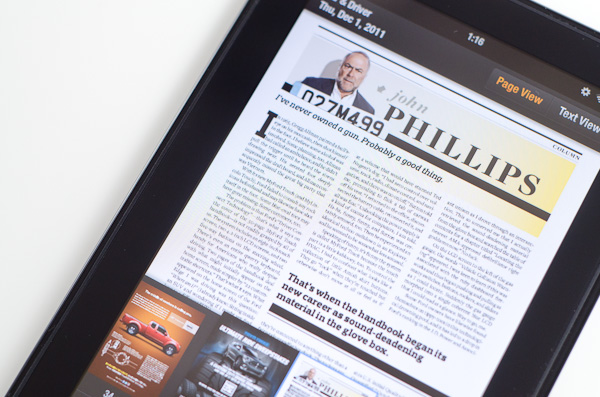








70 Comments
View All Comments
Reflex - Friday, December 2, 2011 - link
So come back in February. By then we'll be on the cusp of a new generation of devices. Right now the Playbook is defficient. Its a nice set of hardware with a lacking software stack. Out of the box it simply does not do what most people want. When it does, I'm sure AT will check it out, but having them review it now is likely to simply get it slammed since it simply won't work for most people who do not already own a BB.ComputerGuy2006 - Tuesday, November 29, 2011 - link
The "final words" section says "The Kindle Fire is probably the best tablet you can buy at $199.". This is troubling.It was never explained how a $200 playbook isnt as good as the $200 kindle. Seems to me the playbook has double the ram and double the storage space. The playbook has two camera and a micro-HDMI port.
So as long RIM can keep its promise and make the playbook capable of running android apps, I dont see how the kindle can beat the playbook in ANYWAY unless you want to spend lots of money on the amazon app store.
VivekGowri - Wednesday, November 30, 2011 - link
Honestly, as tempting as the PB is at $199, RIM's utter failure to deliver features that were promised at launch even 8 months after release is pretty worrying. The lack of native email, contacts, and calendar as of December 2011 is blatantly unacceptable.doesitreallymatter - Friday, December 2, 2011 - link
It is unacceptable that those key apps are lacking. In 2 months when/if RIM delivers these apps, what will be your opinion then?As long as those apps are delivered along with the android support, I just don't see how the Fire can compete with the playbook.
I just don't understand how the conclusion has no mention of the playbook at all.
Reflex - Friday, December 2, 2011 - link
It also does not mention the Nook Tablet. Why? Because it hasn't been reviewed it. If the Playbook becomes competitive, and thats a big if honestly, I'm sure they'll take a look. But really, February? You mean almost a year after the device they give it basic functionality everyone else has shipped with from the beginning?For me, even if the Playbook was competitive, I just can't see that as a well supported platform worth me investing into the ecoysystem of.
dgburns - Wednesday, December 7, 2011 - link
Perhaps you missed the announce a while ago that RIM has dropped the Android App Player from development? So your touted "android support" isn't coming....dgburns - Wednesday, December 7, 2011 - link
The Playbook will NEVER have the ecosystem Amazon delivers with the Fire. As many commentors have implied, that's a HUGE differentiator.And to those who say the PlayBook is the better device at $199 if you own a BlackBerry smartphone already, I disagree. I've got TWO BlackBerry smartphones (different models, from two employers) and as nice as the PlayBook hardware is I STILL don't want one. Even "bridged" to a BB, the PlayBook is SO limited. Will it get better come February (or whenever RIM REALLY releases a update)? Probably, but even then it won't have the ecosystem the Fire brings.
jedivulcan - Tuesday, November 29, 2011 - link
I wish this review went into a bit more nitpicking with the display like I've seen with the other AnandTech reviews. In my experience with having two Kindle Fires, the displays are so wildly different that it's almost like looking at two different products when you have them side by side.The first Kindle Fire I received from Amazon on the day it came out had a duller backlight, some backlight bleeding when viewing older television shows on Netflix, and warmer, almost yellow colors, one or two dead pixels, and hit or miss viewing angles.
The second one I got a week later had a brighter backlight, a ton of backlight bleeding, bright dead pixels on the screen (very apparent in one location), cool blue washed out colors, and terrible viewing angles.
https://img.skitch.com/20111130-x9fq2qskte8kas62jg...
https://img.skitch.com/20111130-dm18ykeb8kud98w4t2...
Reflex - Tuesday, November 29, 2011 - link
Totally bizarre. I'm not implying you haven't seen what you've seen, but I've handled more than a dozen Fire's now and the screens have been consistent with each other and very very high quality. The one I own and took on trips got noticed repeatedly and the first comment most people had was about how nice the screen looked. Its typically the standout feature hardware wise from most people I've discussed it with.Your situation is odd to me because normally I'd suspect a bad run, but you got them a week apart. I really have no idea, but I will say it does not jive with my anecdotal experience or what I"m reading elsewhere. Anyone else see this issue?
VivekGowri - Wednesday, November 30, 2011 - link
Hmmm mine is totally fine, so was Anand's. I really, really like the display quality, though I would have preferred a more neutral colour temperature. I'm not sure why you had so many issues with the display, that's very very odd.